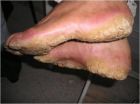(Press-News.org) Combat-ready spikes which shoot from fingers sounds like the weaponry of a comic book hero, but a Japanese scientist has found exactly this in a rare breed of frog. The discovery, which is published in the Journal of Zoology, reveals how the Otton frog uses spikes which protrude from a false thumb for both combat and mating.
The study, conducted by Dr Noriko Iwai from the University of Tokyo, focused on the Otton frog (Babina subaspera), whose habitat is the Amami islands of Southern Japan. Unlike most other frogs the Otton has an extra digit-like structure, a trait it shares with the five-fingered Hypsiboas rosenbergi frogs of Latin America.
"Why these 'fifth fingers' exist in some species remains an evolutionary mystery, but the extra digit of the Otton is in fact a pseudo-thumb," said Dr Iwai. "The digit encases a sharp spine which can project out of the skin, which fieldwork demonstrates is used for combat and mating."
Dr Iwai has studied the rare frogs since 2004 in order to understand the species' distribution, breeding habits and range; all factors which will contribute to any conservation strategy. Once she began exploring how the Ottons use their pseudo-thumbs Dr Iwai discovered that while both males and females had the spike, it was only used by males.
Males were found to have larger pseudo-thumbs than the females and Dr Iwai believes that the spikes evolved for anchoring to the female, known as amplexus, the Latin for embrace, during mating.
"While the pseudo-thumb may have evolved for mating, it is clear that they're now used for combat," said Dr Iwai. "The males demonstrated a jabbing response with the thumb when they were picked up, and the many scars on the male spines provided evidence of fighting."
The conditions on the Amami islands make combat, and the need for weaponry, a key factor for the frogs' mating success. Individuals fight over places to build nests, while the chances of a male finding a mate each night are rare, thus the ability to fight off competitors may be crucial.
Perhaps unfortunately, the comic book hero image is slightly dented by the frogs' fighting style. Rather than dueling with thumb spikes the males wrestle each other in an embrace, jabbing at each other with the spines. This fighting style helps confirm the theory that the spines were original used for embracing mates.
"More research is needed to look at how the pseudo-thumb evolved and how it came to be used for fighting," concluded Dr Iwai. "The thumbs use as a weapon, and the danger of the frogs harming themselves with it, makes the Otton pseudo-thumb an intriguing contribution to the study of hand morphology."
### END
How flick knife thumbs help Japan's rare fighting frogs
2012-10-18
ELSE PRESS RELEASES FROM THIS DATE:
Ozone affects forest watersheds
2012-10-18
U.S. Forest Service and Oak Ridge National Laboratory (ORNL) scientists have found that rising levels of ozone, a greenhouse gas, may amplify the impacts of higher temperatures and reduce streamflow from forests to rivers, streams, and other water bodies. Such effects could potentially reduce water supplies available to support forest ecosystems and people in the southeastern United States.
Impacts of ozone, a global scale pollutant, on forests are not well understood at a large scale. This modeling study indicates that current and projected increases in ozone in the ...
Ongoing disparities in breastfeeding highlighted at Fourth Annual Summit on Breastfeeding
2012-10-18
New Rochelle, NY, October 18, 2012—Despite efforts to reduce disparities in breastfeeding, only 44% of African-American women report that they breastfeed compared with 66 and 68% of Hispanic and white women, respectively. According to UNICEF, there is a 14-fold difference in survival rates in the first 6 months, in developing countries, between children who have been breastfed exclusively and non-breastfed children. These disparities in breastfeeding and other key challenges and opportunities in the ongoing mission to encourage and support breastfeeding are discussed in ...
New tools for assessing the patient's experience with health care--progress report
2012-10-18
Philadelphia, Pa. (October 18, 2012) - An ongoing program is developing new tools for assessing health care quality from the most important viewpoint—that of the patient receiving care, according to a special supplement to Medical Care. The journal is published by Lippincott Williams & Wilkins, a part of Wolters Kluwer Health.
The special issue presents a progress report on the Consumer Assessment of Healthcare Providers and Systems (CAHPS®) surveys —an Agency for Healthcare Research and Quality (AHRQ) initiative to capture patients' perspectives on healthcare. The ...
A*Star scientists identify mutation that causes skin hyperproliferation
2012-10-18
1. Scientists have identified a mutation in a gene that causes patches of very thick skin to appear on the palms and soles of affected people. This skin disorder is related, albeit in a much milder form, to that of the Indonesian 'Tree Man', Dede Koswara . These thick rough skin patches on hands and feet steadily increase in number as a person ages and often coalesce to form larger lesions. In severe cases, these lesions can be painful and debilitating.
2. The team of scientists from A*STAR's Institute of Medical Biology (IMB), in collaboration with hospitals and research ...
Developed a technology that predicts metastasis in breast cancer
2012-10-18
Researchers at the Bellvitge Biomedical Research Institute (IDIBELL) and The Institute of Photonic Sciences (ICFO) have collaborated on the development of a diagnostic tool that identifies the metastatic ability of breast cancer cells. The analysis is based on the characterization of the lipid component of the cells, which is indicative of malignancy. This has allowed the researchers to develop a classifier to discriminate cells capable of inducing metastasis. The results of the study have been published in the online version of the scientific journal PLoS ONE.
The characterization ...
New study shows reprogrammed amniotic fluid cells could treat vascular diseases
2012-10-18
NEW YORK (Oct. 18, 2012) -- A research team at Weill Cornell Medical College has discovered a way to utilize diagnostic prenatal amniocentesis cells, reprogramming them into abundant and stable endothelial cells capable of regenerating damaged blood vessels and repairing injured organs.
Their study, published online today in Cell, paints a picture of a future therapy where amniotic fluid collected from thousands of amniocentesis procedures yearly, during mid-pregnancy to examine fetal chromosomes, would be collected with the permission of women undergoing the test. These ...
From the Alps to the Deep Mantle
2012-10-18
Boulder, Colo., USA – Geology articles posted online ahead of print this month survey topography, minerals, faults and tectonics, alluvium, modeling, snowball Earth, fossils and extinction, and pyrite-filled worm burrows. One notable study provides a new eruption date for the Salton Buttes (Calif., USA) of 30,000 years later than that determined by earlier studies, coinciding with the appearance of the earliest known obsidian tools there.
Highlights are provided below. GEOLOGY articles published ahead of print can be accessed online at http://geology.gsapubs.org/content/early/recent. ...
Germs in space: Preventing infection on long flights
2012-10-18
PROVIDENCE, R.I. [Brown University] —The cabin of a spacecraft halfway to Mars would be the least convenient place -- one cannot say "on earth" -- for a Salmonella or Pneumococcus outbreak, but a wide-ranging new paper suggests that microgravity and prolonged space flight could give unique advantages to germs. What's a space agency to do? Brown University and Rhode Island Hospital infectious disease expert Dr. Leonard Mermel offers several ideas.
And no, they are not to add more Vitamin C to the Tang, or to give each crew member a bottle of Purell. It's a lot more complicated ...
Technology has improved voting procedures
2012-10-18
PASADENA, Calif.—Thanks to better voting technology over the last decade, the country's election process has seen much improvement, according to a new report released today by researchers at Caltech and MIT. However, the report notes, despite this progress, some problems remain.
Spurred by the debacle of hanging chads and other voting problems during the 2000 presidential election, the Voting Technology Project (VTP) was started by Caltech and MIT to bring together researchers from across disciplines to figure out how to improve elections. The VTP issued its first report ...
Might lefties and righties benefit differently from a power nap?
2012-10-18
NEW ORLEANS, La. — People who like to nap say it helps them focus their minds post a little shut eye. Now, a study from Georgetown University Medical Center may have found evidence to support that notion.
The research, presented at Neuroscience 2012, the annual meeting of the Society for Neuroscience, found that when participants in a study rested, the right hemisphere of their brains talked more to itself and to the left hemisphere than the left hemisphere communicated within itself and to the right hemisphere – no matter which of the participants' hands was dominant. ...



